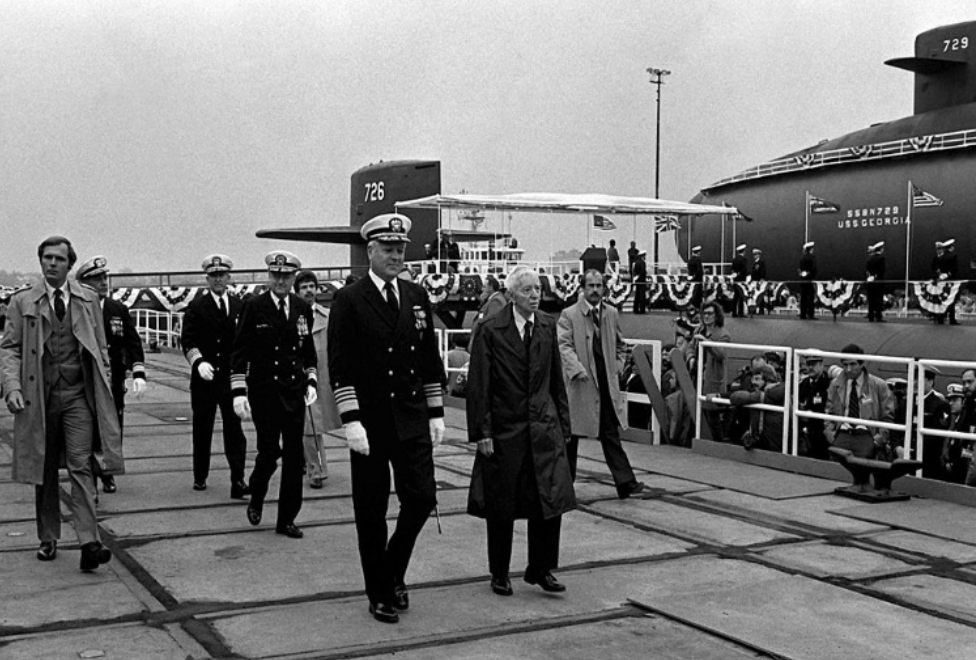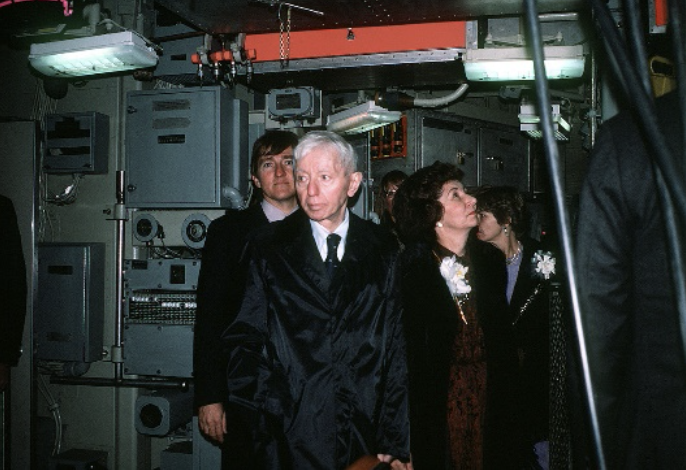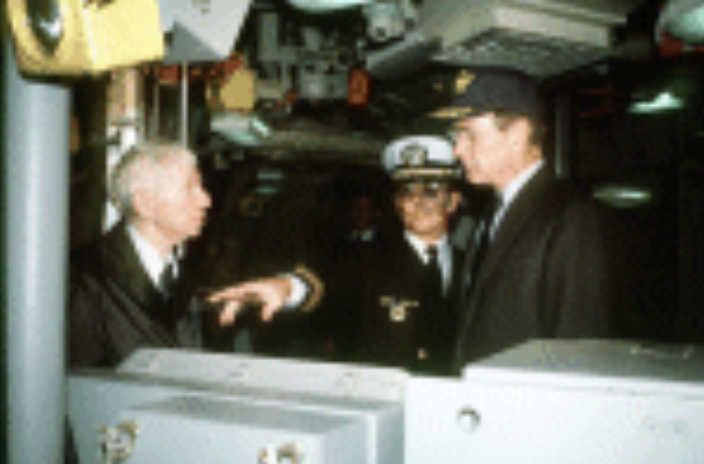Admiral Rickover Observations
By John Paulson, Captain, USN (Ret.)
I had one personal meeting with Admiral Rickover, the one necessary for entry into his Nuclear Propulsion Program. Therefore, my 1971 meet and-greet is similar to thousands of others. The morning interviews with the NR staff I thought had gone well, plus I didn’t have to sit and wait very long before I was called to enter the sparse office. It was nicer than I thought it would be; so was the Admiral. Following the staff’s directions for getting to my assigned chair, which didn’t wobble, I sat when directed. The Admiral was scanning through page(s) of my information before him and began a sort of soliloquy regarding my record and academics, which required only a few “Yes, sir” responses as he spit out parcels of what he noted in the record. Then, he barked at me about not becoming a slacker and coasting the rest of the year to graduation. I said “No, sir, I won’t”. He said “alright, I want you to write to me every two weeks and let me know how much you actually study.” I said “Yes, sir” and followed the directions of the accompanying staff member to stand-up and leave the room. Once outside the office, I asked for the correct address to get my letters to the Admiral, and contemplated the future for the rest of the short winter afternoon. I was happy that the meeting with the old goat was over, and that I had not given him an obvious reason to say “no: to enter the program. My course grades had gone up each semester from Plebe year to First Class year, starting at 3.00 (B) to the most recent 4.00 (A), so I had signed-up for a difficult task to keep them there.
To me, the interview experience was anti-climactic, or so I thought. After all the spine-tingling stories I had heard about the kindly old gentleman, I was a bit let down. I really didn’t expect any hysterics from him, especially since I had already completed my major field of mathematics study thanks to a year of hard-core study at the University of Wisconsin after high school. It had enabled me to obtain a qualified alternate appointment to USNA and to validate 34 credit hours of academics. So, I was writing my letters every two weeks, for a few core subjects plus Advanced Navigation Systems, Reactor Physics, Statistical Physics, Numerical Methods for Differential Equations, Electricity and Magnetism II, and Control Systems & Their Applications. Then the future changed a bit. I got one B that semester and I was accepted to the Naval Post Graduate School at Monterey. So, I had some explaining to do in my next letter, and my entry into the Nuclear Propulsion Program would be delayed a year to fall 1972.
Then the future changed a bit more. Later that winter, I was attending a conference of the American Chemical Society in Washington DC and encountered an academic head-hunter of sorts, the Chancellor of the University of California. He had military officer billets to fill at the Lawrence Livermore National Laboratory with the university’s Engineering Applied Science program. It was Dr. Edward Teller’s doctoral feeder program of a few dozen students per year, run from classrooms in a group of Quonset huts on the east side of the Lab in Livermore, CA. Dr. Teller and Admiral Rickover, as most know, had a history. There are photos, news articles, letters, and book excerpts to prove it. The outcome for me “crossing to the dark side” was uncertain. I kept writing my letters to Admiral Rickover every other week, ending with my worst grades since Plebe year, which I explained in my last letter to him. I actually went upward in class rank, as many others slid further down the slide of academics which the Admiral had predicted.
I didn’t have to write letters to Admiral Rickover from Livermore. I had to work hard from the start, completing the Master’s Degree portion of the curriculum in three vs the normal six quarters of study, on 13 June, 1972. Then I received a letter from Captain A.L. Keln, USN which said: “Per new provisions of SECNAVINST 5420.41, your total initial service obligation has been reduced to five years. This is considered an insufficient period to permit a reasonable return to the Navy for the time and expense involved in nuclear power training, which you will receive. Please indicate either your willingness to meet the revised 4-year obligation from the time of your graduate school completion, or your desire to be released from nuclear power training commitments”. Since my original 5 years would complete on 8 June, 1976 and my new date would be 13 June, 1976, I agreed to the new term of 5 additional days, which were accepted by the Navy. So, newly married, we moved 45 miles from Livermore, CA to Vallejo, CA for Nuclear Power School.
While waiting for the next class to begin, I was assigned to USS Plunger (SSN 595) from 13 June – 5 September, 1972, which was undergoing overhaul in Mare Island Naval Shipyard. That shipyard period, combined with my 2-month midshipman cruise aboard a submarine in San Diego the previous summer, prepared me well for what would become another 29 years in the Navy. During my first 10 years, we were fortunate to get my wife’s homeport choice of Hawaii, twice, with a tour teaching at Nuclear Power School in Orlando between the sea tours. When the kindly old gentleman was told to retire in November, 1981, I was Chief Engineer on USS Skate (SSN 571), preparing for deployment to WESTPAC to hold back the Red Tide, if necessary. Rickover last rode Skate on her initial sea trials on 27 October, 1957, my ninth birthday.
A few months before deployment during lunch, the wardroom telephone rang. “I answered, Skate wardroom, Engineer speaking, sir.” The phone barked back in familiar tones “I want to speak with the Captain. It was Admiral Rickover “live” on the line. The CO, seated at the head of the wardroom table, didn’t believe me until I pointed the handset toward him to hear the sound of Rickover’s voice loud and clear, chewing out someone back in DC.
I addressed the call’s issue in the next quarterly letter I drafted to Rickover for the CO, regarding our shipboard training program and any propulsion plant issues. It was my last “live” and written interaction with the Admiral. The letters to NR continued after his retirement, but were still called “Rickover Letters”. That tradition probably continues to this day.
Earlier that year, on 20 June, 1981, Rickover rode the first Trident submarine, USS Ohio (SSBN 726), on her initial sea trials. It was followed by three initial sea trials for 688 class submarines: USS La Jolla (SSN 701) 26 July, USS Phoenix (SSN 702) 28 September, and USS Boston (SSN 703) 9 November.
According to Rickover, he first learned of his firing after returning from sea trials on USS Boston (SSN 703), when his wife Eleonore told him what she heard on the radio. Two days later, USS Ohio (SSBN 726) was commissioned.
Subsequent to the USS Ohio (SSBN 726) commissioning, Admiral Rickover was summoned to the office of Secretary of Defense Caspar Weinberger and told that the President had decided not to renew his appointment to Admiral. Weinberger and Navy Secretary John Lehman made nice little speeches about Rickover’s contributions, but when they turned to him for a response, Rickover just got up and walked out of the room. There was no more to be said. His career was over. On 8 January, 1982, Admiral Rickover was called to the Oval Office for a farewell meeting with the President. On January 19, 1982 he retired from the Navy, on January 29, 1982 he left his Naval Reactors offices for the last time, and on January 31, 1982, four days after his 82nd birthday, Rickover’s official forced retirement from the Navy went into effect after 63 years of service under 13 Presidents (Woodrow Wilson through Ronald Reagan).
P.S. My next assignment was XO of the 6th new construction Trident in 1982. Seven duty stations later, including budget officer for NR and nuclear sub maintenance, I oversaw Admiral Rickover’s 18 Ohio Class subs and their missiles and Dr. Teller’s nuke warheads afloat and ashore as Deputy Director and IG at Strategic Systems Program Office in DC. Thanks, Admiral.

NOTE: Official Navy Photo: USN photo # DN-SN-82-01597 by PH2 Robert Hamilton, from the Department of Defense Still Media Collection, courtesy of dodmedia.osd.mil.

